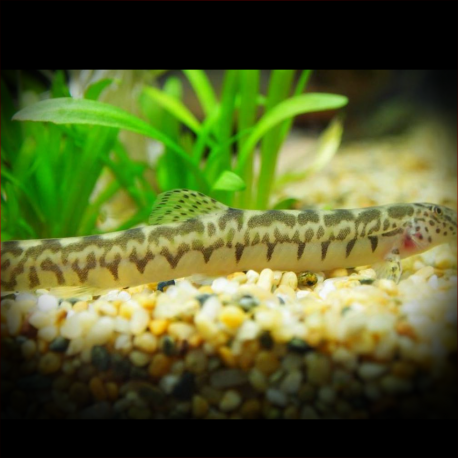More info
Datasheet
| Minimum Tank Size | 90 litres / 23.78 US gallons |
| Maximum Size | 16.0cm / 6.30inches |
| Temperature | 20°C / 68.00°F - 24°C / 75.20°F |
| Hardness | 5.04dgH / 90ppm - 15.02dgH / 268ppm |
| pH | 7.0-8.0 |
Behaviour
Iksookimia spp. are known for their peaceful nature towards both their own species and other fish in the aquarium. There are no documented instances of them causing harm to tankmates, although they may consume eggs or fry. These fish thrive best in the company of conspecifics and tend to do well when kept in a group of four or more individuals. When selecting tankmates for Iksookimia fish, it is advisable to choose small, peaceful cyprinids, along with current-loving loaches from specific genera such as Gastromyzon, Pseudogastromyzon, Beaufortia, Sewellia, and docile nemacheilids. Additionally, rheophilic gobies from genera like Sicyopterus, Stiphodon, Rhinogobius, and Lentipes can also make interesting companions in the same community setup. However, it is recommended to avoid pairing Iksookimia with territorial or aggressive bottom-dwelling species like certain substrate-dwelling cichlids and some nemacheilid loaches.
Feeding and Diet
Iksookimia species primarily feed as micropredators in the wild, preying on chironomid larvae and benthic invertebrates. In the aquarium environment, these fish can be fed sinking dried foods but should also be provided with regular meals of small live and frozen foods such as Daphnia, Artemia, and bloodworms to ensure a varied diet essential for their optimal health.
Reproduction & Dimorphism
While the exact reproductive behavior of Iksookimia fish is not well-documented, they are presumed to be seasonal spawners in their natural habitat. As of present knowledge, breeding these species successfully in captivity has not been reported. In terms of sexual dimorphism, adult female Iksookimia individuals typically exhibit a heavier body structure and are slightly larger compared to males. Mature males often develop extended pectoral fins, particularly the second ray, and possess a distinctive thickened structure known as the lamina circularis at the base. The size of the lamina circularis is a key identifying feature of this species, as it is notably smaller in Iksookimia compared to other members of the genus.
Habitat and Distribution
Iksookimia species, such as Iksookimia Yongdokensis, are endemic to Korea. Specifically, I. Yongdokensis is native to the eastern province of Gyeongsangbuk-do in South Korea, where it is found in various river drainages including Hyongsan, Yongdokoship, Chuksan, and Songcheon. These fish inhabit sluggish, shallow waters with substrates consisting of sand or pebbles in the mid to upper sections of rivers. In their natural environment, Iksookimia fish have been observed alongside other species like Squalidus multimaculatus, Phoxinus oxycephalus, Carassius auratus, Nipponocypris temminckii, Misgurnus anguillicaudatus, and Rhinogobius brunneus.

